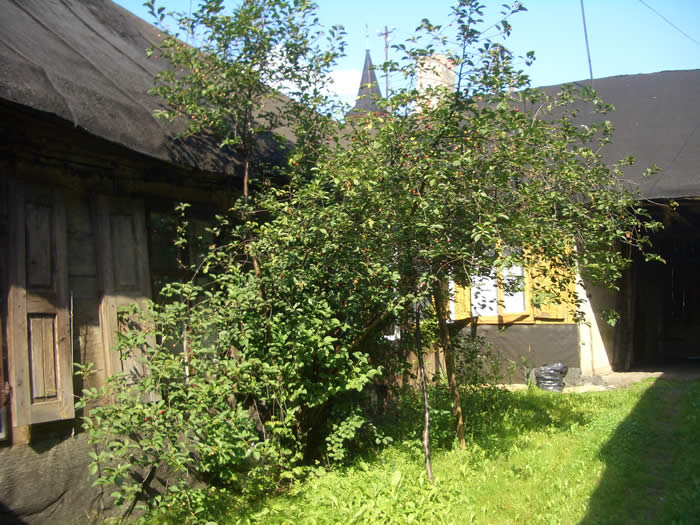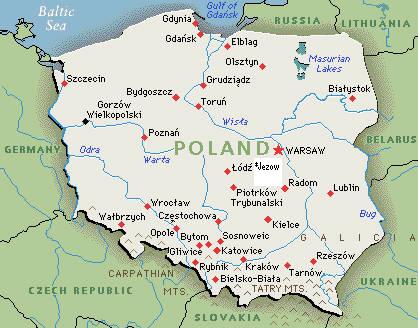Virtual Shtetl states that "Jews
lived in the area which was assigned to them in 1826, located in
the neighbourhood of Piotrkowska, Brzezinska and Stodolna Streets.
Most probably, a synagogue was built and a cemetery was
established in Piotrkowska Street in the first half of the
nineteenth century. The first wooden synagogue burnt down in one
of the fires that destroyed the city and a stone one was built at
the site of the original synagogue in circa 1890."
Szlama Wajnberger (or Weinberger)
was the rabbi of Jez�w until age or infirmity forced him to
resign. In 1879, he was replaced by Rabbi Yakov Landau, son
of the famous rabbi of Ciechanow, Abrahamele Landau. Rabbi
Yakov Landau is buried in Warsaw. (Thanks to genealogy
researcher David Landau for this information about Jez�w's
rabbis.) For more information about the Jewish life in
this village, see the translation of the Pinkas
Ha Kehilot be Polin ? Vol 1 for Jez�w.
The census of 1921 showed that
1,048 residents of Jez�w (i.e. 39.5% of the whole population)
declared their Jewish origin. The economic crisis of the
1930s contributed to anti-Semitic outbreaks were frequent between
the World Wars, especially in 1935.
World
War II
According to the Encyclopedia
of Camps and Ghettos, 1933-1945, following the occupation
of the town by the Germans in September 1939, the German
authorities introduced a series of anti-Jewish measures in the
fall. Jews were forced to wear the Star of David armbands; Jewish
children were no longer permitted to go to school; and Jews were
subject to forced labor. On September 9, 1940, the Kresihaptmann
in Skierniewice, Regierungsrat Dr. Rupe reported to Governor Hans
Frank in Krakow that there were 1,400 Jews living in Jezow.
The Jezow Ghetto was probably
established in fall, 1940. The ghetto was set up over a
period of time. The Germans divided the town and moved the
Poles into the better Jewish hosues and then crammed the Jews
together. Even some houses were divided, half with Poles and
half with Jews. In January, 1941, about 1,600 Jews were
living in Jezow with about 600 were refugees from Lodz and other
towns. At that time, the Jews were informed that they would be
transferred to the Warsaw ghetto. On March 4, 1941, most of
the Jews had voluntarily moved to Warsaw.
On arrival in the Warsaw ghetto,
most of the Jews from Jezow were put into improvised hostels
designated for refugees. A report noted the terrible conditions in
one of these shelters. A large numberof the refugees from Jezow
died of starvation and contagious diseases in the Warsaw
ghetto. Most of those who survived until the summer of 1942
were among those deported to the Treblinka extermination camp at
that time.
Other WWII Accounts
In 2011, I listened to the 1996 Shoah
Foundation interview of survivor Maurice
Rosenthal. He reported that Jewish people were very
discernable from non-Jews in Jezow because of their appearance
(notably, dark curly hair) and their distinctive accent
(Yiddiih-accented Polish. Mr. Rosenthal stated that when the
Germans invaded, German soldiers rounded up all of the men in
Jezow, including non-Jews and kept that imprisoned for several
weeks. All but the Jewish men were released. A ghetto
was established in Jezow at this time, and all the Jews had to
wear the Star of David. They were not allowed to cross the highway
which led to Warsaw.
According to Virtual Shtetl,
the Nazis destroyed the Jezow synagogue as well. According to one
source, on February 1, 1941, the 1,570 Jews of Jez�w, including
more than 600 refugees were expelled to the Warsaw Ghetto.
(This information was also found in Rabbi Shepansky's "Holocaust
Calendar of Polish Jewry").
However, in a recent interview
(June 2010) I had with a town resident, I learned that Jews were
rounded up in 1942 and deported to the ghetto at nearby Rawa
Mazowiecka and from there were taken to Treblinka.
(For more information, go to Rawa
Mazowieka Pinkas) In his testimony, Mr.
Rosenthal indicated that Jez�w Jews were given a choice of being
deported to Warsaw or Rawa Mazowiecka.
Virtual Shtetl states that "more
than 900 people of Jewish origin settled in Jez�w after the
liberation. Surely, this number included not only former Jewish
residents of this town. On average several dozen of people from
much bigger ?shtetls? managed to survive the Holocaust. It is
believed that they were mainly repatriates from the east, many of
them having settled down at that time e.g. in L�dz. However, most
of them left Jez�w soon. Out of 937 persons of Jewish origin
living in Jez�w in 1945, only 229 were left by 1950 and five years
later Jewish population numbered 25. There were officially no Jews
there in 1970."
A list of 19 Holocaust victims
from Jezow can be found at Yad
Vashem. Type in "5729405" under "general
search" to find the list. The list is obviously incomplete.
A list of 35 survivors who
indicated that they were from Jezow, (Documber No. 78823188#1,
from the ITS Digital Archives at Bad Arolsen can be found here.
Jez�w?s 2006 population was
approximately 3,600. There are presently no Jews.
Some pictures of old Jezow and an
old map can be found at Bagnowka
(http://www.bagnowka.pl/?m=atoz&g=4801)
1] Monika Borkowska "Monografie
cmentarzy Jezowa", praca licencjacka, Uniwersytet L�dzki, Katedra
Geografii Miast i Turyzmu, 2001 r.
2]
Jan J�zefecki, Maria Piekut, Jan Wieslaw Wysocki "Zarys dziej�w
Jezowa?, 1985 r
3] Shmuel
Spector "The Encyclopedia of Jewish life before and during the
Holocaust"
Compiled
by Deborah H Long
Updated
January
2023
Copyright � 2010-2026 Deborah
H Long
This page is hosted at no cost to the
public by JewishGen, Inc., a non-profit corporation. If
you feel there is a benefit to you in accessing this site, your
JewishGen-erosity is appreciated.
Please here
to make a donation.
![]()


